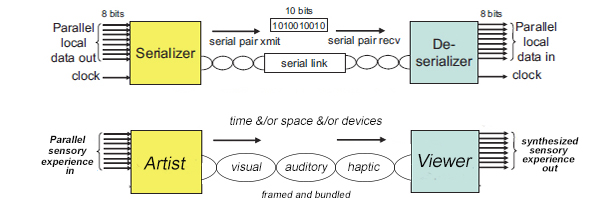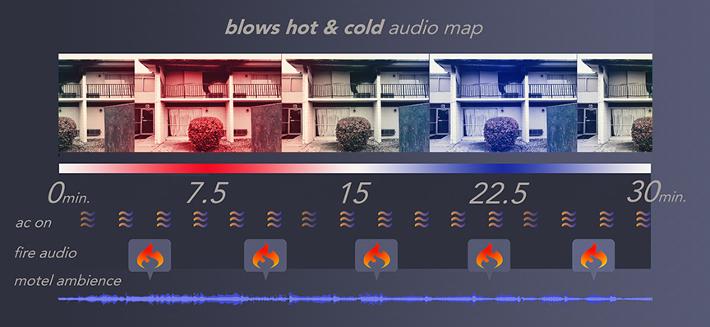
Blows Hot and Cold (original working sketch) appliances, single channel video 132" X 110" X 62" dur. 30 min. 2014
The video consists of a cell phone still taken of the aftermath of a motel fire that cycles almost imperceptibly slowly over the course of 30 minutes from red tint to blue tint, alternately zooming in on a burning bush that did not burn and on an air conditioner that did. The air conditioner in the piece cycles on ever 110 seconds. The barely audible motel ambiance that emanates from the overhead amp gives way to sudden intermittent outbursts that begin as a warning and escalate to a threat. The piece alternates from passivity to panic, boredom to urgency.
Blows Hot and Cold is a response to technological and aesthetic convergence, two trends that aggregate technology into ever more compact devices and concentrate attention into ever more focalized media interactions. With Blows Hot and Cold I attempt to parcel and distribute the event over devices, space and time, smearing the aesthetic encounter over uncomfortably large zones of perception and attention.
the artwork does not fulfill desire, it unfulfills it.
- Jean-Fancois Lyotard
I shot the image that became the basis for Blows Hot and Cold with my cell phone when I stopped for gas at a station that sits in front of this rather seedy motel just off the freeway and down the street from the university where I teach. At the time, I felt the need to document the scene, but, as is often the case, I wasn't quite sure why. There was a structural relationship that was intriguing, a kind of equivalence between a burning bush that did not burn and an air conditioner that did. Irony aside, I came to recognize a tension between the cold arithmetic formality of the scene and the way that it also suggested some sort of lurid backstory. In my mind the photograph toggles between deadpan matter-of-factness and dramatic evocation. My fascination is a consequence of the fact that I don't know what to do with the image: Do I engage in a "hot" narrative reading or a "cold" structural analysis? For all it's stillness this image is amazingly elusive. Like the motel it depicts, it seems to me a site of transience and ambiguity, a place of movement that itself never moves, physically and symbolically stationed at the edge of the city and the social order.


Julia Kriseva developed the concept of abjection to describe the adverse response that we have to things that disrupt conventional categories or lie outside of the symbolic order. This is closely related to Masahiro Mori's famous diagram of the uncanny valley, a graph that illustrates our emotional reactions to ambiguity. We tend to respond positively to objects as they appear increasingly human, but only up to a point. Once the similarity begins to blur conventional categories such as animate/inanimate, human/inhuman, the bottom falls out. Freud's uncanny, Kristeva's abject and Mori's graph all point to how indeterminacy, not knowing (un-canny), can yield fascination but also revulsion and hostility. It should be remembered that a more precise, if clumsier, translation of Freud's unheimlich is un-homey rather than uncanny. Ambiguity in this case is proximal,lurking in the guise of the familiar, making that which is closest to us suddenly feel distant, peripheral and strange. Proximity and familiarity are crucial factors in determining what is or can become uncanny. The framing of experience that is provided by social conventions and habitual expectations are at least as critical as perception itself in giving shape to lived experience.


Mori's Uncanny Valley appears as a dramatic dip in a viewer's comfort level arising from conflicting cognitive representations. In Blows Hot and Cold the audio cable inscribes Mori's famous graph as the separation of its audio and video components. The liminal space that separates the perceptual events is the central motif of the piece.
Blows Hot and Cold is designed to work the edges of viewers' perceptions. The video slowly zooms in and shifts it's tint from red to blue over the course of 30 minutes. Conventional viewing habits will lead most viewer's to assume that the image is static. It's only when one walks away and then is called back by the audio outbursts that one realizes that something has changed. Ambient audio of the motel runs for the entire length of the piece, but it is separated from the video by almost 10 feet. The volume is set so that it operates just at the edges of audition. I conceived of the ac unit as a "distractor," its cool breeze adding a haptic sense modality to the piece. This makes BH&C more fully experiential but also the noise of its cycling on and off distracts the viewer from the screen so that when they return to it they become aware of the subtle shifts in composition and hue that are difficult to observe directly. The piece intentionally challenges conventional aesthetic trends towards the convergence of devices and the increasing focalization of attention that results from "screen culture." I wanted to smear the event over time, appliances and space, taking a somewhat different approach to challenging perceptual norms than is used in typical endurance artworks or immersive environments. The model I am using is closest to the packetiztion and framing strategies that are commonly used to bundle audio/visual bit streams for transmission. Viewers are forced to navigate the various perceptual frames or "sensory bundles" and then synch them (or not)into an experiential totality.

Packetization model for BH&C (diagram based on PCI Express). The Serializer shown at top encodes clock, frame, and eight bit data bundles into a 10-bit stream. Below, framing and bundling as applied to deployment of percepts in the sensorial field.
Every 220 seconds the cool formality and monotony of the piece suddenly heats up as the barely audible motel ambiance is swamped by a husky male voice repeatedly screaming, "FIRE! FIRE! FIRE!" What seems at first to be a panicked warning becomes more troubling as it transitions to, "OPEN FIRE! OPEN FIRE!" This too eventually morphs into "KILLER WITH FIRE! KILL'ER WITH FIRE! KILL HER WITH FIRE!" Then as suddenly as it started, the piece resumes its quiet monotony. As it continues to alternate from passivity to panic, boredom to urgency, viewers are confronted with conflicting cognitive representations. Blows Hot and Cold is an attempt to replicate the same potent ambiguity that I experienced when I first encountered the image.

